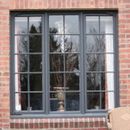Can I reuse single-pane steel sash windows?
A client would like to restore some window openings that were bricked-over by a previous owner. The original single-pane steel sash casement windows had been stored, and are in excellent condition. The building department views these “restored” openings as “new” openings, and requires compliance with the energy code, i.e. window U-factor of 0.30 or better. (The default value for these windows is U=1.20 per Table R303.1.3.)
Granted, this is an aesthetic decision. I doubt we can find any newly manufactured window that can match the appearance of the other windows in the house. I don’t believe there is such a thing as an NFRC-rated storm window.
Does anyone have any thoughts as to how I can legally re-use the beautiful old steel sash?
Thank you.
Climate Zone is 4C (Seattle)
GBA Detail Library
A collection of one thousand construction details organized by climate and house part










Replies
Robert,
You could weld them shut and protect them with a low-e storm window on the exterior. Of course, you would have to get that plan approved by your local building department.
Martin -
What's the purpose of welding them shut? Is this just a spot-weld to render them inoperable, or am I trying to achieve an air seal?
Robert,
A spot weld so no one tries to open them (breaking the storm window in the process).
Martin -
I understand that this will improve the performance of the existing windows (if you don't consider fresh air to be a benefit), but I doubt I can convince the building department that this solution complies with the energy code. Thank you, though: I appreciate your prompt reply.
Robert,
Some people may find this type of window beautiful, but it's hard to imagine a window with worse energy characteristics, or one more likely to be covered with interior frost during the winter.
It's a little bit like a 1967 VW bug. It's a cute car, but it's slow, lacks a decent heater, has sluggish acceleration, and breaks down frequently.
What do you mean? It's EASY to think of a worse performing window- try ALUMINUM sash windows! :-)
As for the interior frost on the window or sash frames, that ain't happnin' in Seattle where the January mean outdoor temp is nigh onto +40F, as long as you have a storm window over the exterior. Even without storms it would barely form frost at the 99% outside design temp (mid-20s F) but it would deliver copious condensation all winter long.
With wood sashes and a low-E storm it could come close to U0.30 with clear glass in the old sashes, but there's no way to clear that hurdle without low-E glazing in the more thermally conductive steel sashes. There's absolutely no way to get it down to even U0.5 without a storm window.
Re-glazing the steel sashes with hard-coat low-E glass (with the low-E coated side facing the exterior) then air sealing the steel sashes to each other and the steel frame and installing a tight non-operable single-light exterior low-E storm window would get you almost down to U0.30 performance, or at least under U0.4. With clear glass in the steel sashes it won't make it, even with low-E storms, unless you add a third pane, like an interior storm with a low-E coating as well.
That may not be the answer you're hoping for, but it's reality (or a near facsimile thereof.)
"Copious condensation all winter long," even in Seattle, is one reason why the local building department is insisting on better-performing windows.
From your photo, I'll guess that it's the outside you want to have the aesthetics of the original. In that case, an interior storm might be the right solution. And there are interior storms that are close to invisible. I haven't seen exterior storms that I'd call invisible.
There's the condensation problem, but also the energy-use problem. U0.5 windows are sufficient mitigation for condensation in that climate, but the stretch codes are now demanding U0.30, slightly better than the U0.32 IRC 2012 code max. (Not a big upgrade from code-max, but some.) A U0.5 window fixes the condensation, but is still a net energy loser, but at about U0.35-0.37 or so even north facing windows gain more heat than they lose over a Seattle heating season.
Using base 65F Seattle has a 10+ month heating season. Using base 60F (appropriate for most post -1990 performance homes) it's still a 8.5-9 month heating season. Even though zone 4C winter extremes are mild compared to zone 4A/4B locations, low window performance still adds up to significant excess energy use- more so than in 4A/B. That is probably why the IRC calls out the same maximum window U-factor for 4C as it does for a much cooler 5A/B climate, and a more relaxed window U-factor for 4A/B.
If the window doesn't get direct sun, a custom fixed U0.35-ish double pane on the exterior might work, but it would be impossible to wash the windows. Low-E reglazing plus low-E storms are really a better solution if you love the things enough to keep them, despite their obvious faults. With one large single-light storm window you'll still retain most of the visual character. If you want the sash frames and muntin bars to remain clearly visible under all lighting conditions with a low-E storm on the exterior you might consider painting them with a lighter shade of grey. With an exterior storm you'll need to truly air-seal the original window to prevent condensing/fogging on the interior surface of the storm window. I doubt there are adequate weather stripping retrofits for the steel sash to eliminate all fogging issues, but caulking it up tight should work.